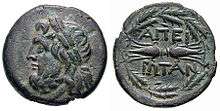Epirote League

The Epirote League (Northwest Greek: Κοινὸν Ἀπειρωτᾶν, Koinòn Āpeirōtân; Attic: Κοινὸν Ἠπειρωτῶν, Koinòn Ēpeirōtôn) was an ancient Greek coalition, or koinon,[1] of Epirote tribes.[2]
History

The coalition was established between 370 and 320 BC (firstly as the Molossian League in 370 BC), which helped unify the three main tribes of Epirus (i.e. Molossians, Thesprotians, and Chaonians).[3] The political, economic, and cultural center of the Epirote League was Dodona.[4] Dodone was the religious, political and cultural centre of the Molossian League and later of the Epirote League. Pyrrhus of Epirus became leader of the League in 297 BC.[5] When King Agathocles of Syracuse conquered Corcyra, he offered the island as dowry to his daughter Lanassa on her marriage to Pyrrhus of Epirus in 295 BC.[6] The island then became a member of the Epirote League. It was then perhaps that the settlement of Cassiope was founded to serve as a base for the king of Epirus' expeditions. The island remained in the Epirote League until 255 BC when it became independent after the death of Alexander II of Epirus. The league was defeated by the Illyrians during the Invasion of Epirus and the Battle of Phoenice, forcing them to enter into an alliance with Teuta to prevent further attacks. This alliance made the Epirotes hostile to the Acheaens and Aetolians, but presumably ended following Illyrian defeat in the First Illyrian War.
Although the Epirote League remained neutral in the first two Macedonian Wars, it was ultimately dismantled in the Third Macedonian War (171–168 BC), with the Molossians siding with the Macedonians and the Chaonians and Thesprotians supporting the Roman Republic.[7]
Decrees of the League
Copies of the decrees (proxeny and citizenship decrees, manumission records) of the Molossian and Epirote League were set up in Dodona. All members had common citizenship.[8] Regarding the dialect of the Epirote League, it was not Corinthian Doric and even the alphabet was not Corinthian; it was probably Northwest Doric, as some recorded inquiries at Dodona appear to indicate.[9] The first epigraphical evidence of the Molossian League goes back to 370 BC under the king (or basileus) Neoptolemus.[10]
See also
| Wikimedia Commons has media related to Epirote League coins. |
References
Citations
- ↑ The full range of meanings can be found under κοινός in Liddell & Scott 1940.
- ↑ Boatwright, Gargola & Talbert 2004, p. 92: "Pyrrhus matched this model. His power base was his kingship over the Molossians, a traditional office with customary limitations. To this he added the post of hegemon, or commander, of the Epirote League, an alliance of Epirote communities to which each contributed forces and funds toward common goals."
- ↑ Walbank 1989, Chapter 10: P. R. Franke, "Pyrrhus", p. 459: "As king of the Molossians - he never styled himself king of the Epirotes and certainly never king of Epirus, a title found especially in the Roman tradition - Pyrrhus was at the same time the hegemon of the Epirote League which was founded around 325/20 and describes itself as the ΣΥΜΜΑΧΟΙ ΤΩΝ ΑΠΕΙΡΩΤΑΝ ('the Epirote allies') on inscriptions. The League united the three main peoples of Epirus (Map 9) - the Molossians, the Thesprotians, and the Chaonians, who were evidently the last to join; each of these in turn consisted of numerous sub-groups."
- ↑ Hansen & Nielsen 2004, p. 343: "Usually Dodone is mentioned as an oracle (Hdt. 2.52) or a sanctuary (Eur. Phoen. 983)."
- ↑ Koester 1995, p. 33: "After a variety of experiences Pyrrhos had become king of the Molossians and leader of the Epirote league in northwestern Greece (297 BCE)."
- ↑ Chamoux 2002, p. 59; Walbank 1989, Chapter 10: P. R. Franke, "Pyrrhus", p. 458.
- ↑ "Epirus". Encyclopaedia Britannica. Encyclopaedia Britannica, Inc. Retrieved 16 November 2013.
- ↑ Eidinow 2007, p. 59: "...to the gradual weakening of the Molossian monarchy and the formation of the Epirote League, in which the members had common citizenship (233/2-168 BCE)."
- ↑ Lewis & Boardman 1994, Chapter 9: N. G. L. Hammond, "Illyrians and North-West Greeks", p. 434.
- ↑ Cabanes, L'Épire 534,1
Sources
- Boatwright, Mary Taliaferro; Gargola, Daniel J.; Talbert, Richard J. A. (2004). The Romans: From Village to Empire. Oxford and New York: Oxford University Press. ISBN 0-19-511876-6.
- Chamoux, François (2002). Hellenistic Civilization. Oxford: Blackwell Publishing. ISBN 0-631-22241-3.
- Eidinow, Esther (2007). Oracles, Curses, and Risk among the Ancient Greeks. Oxford and New York: Oxford University Press. ISBN 0-19-927778-8.
- Hansen, Mogens Herman; Nielsen, Thomas Heine (2004). An Inventory of Archaic and Classical Poleis. Oxford and New York: Oxford University Press. ISBN 0-19-814099-1.
- Koester, Helmut (1995). Introduction to the New Testament, Volume 1: History, Culture, and Religion of the Hellenistic Age. New York and Berlin: Walter de Gruyter. ISBN 3-11-014692-4.
- Lewis, David Malcolm; Boardman, John (1994). The Cambridge Ancient History: The Fourth Century B.C. Cambridge: Cambridge University Press. ISBN 0-521-23348-8.
- Liddell, Henry George; Scott, Robert (1940). A Greek-English Lexicon. Oxford: Clarendon Press.
- Walbank, Frank William (1989). The Cambridge Ancient History Volume 7, Part 2: The Rise of Rome to 220 B.C. Cambridge: Cambridge University Press. ISBN 0-521-23446-8.